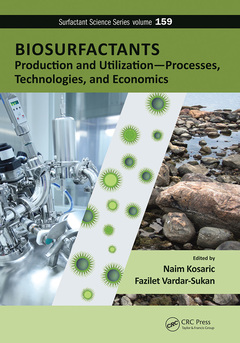Description
Biosurfactants
Production and Utilization—Processes, Technologies, and Economics
Surfactant Science Series
Coordinators: Kosaric Naim, Sukan Fazilet Vardar
Language: English
Subjects for Biosurfactants:
Keywords
Biosurfactant Produced; Rhamnolipid Production; production; Foam Fractionation; rhamnolipid; MEL; candida; Sophorolipid Produced; bombicola; Lipopeptide Biosurfactant; fatty; Chemical Surfactants; acid; Microbial Surfactants; foam; Rhamnolipid Biosynthesis; fractionation; Non-ribosomal Peptide Synthetases; lipopeptide; Microbial Biosurfactants; enhanced; Acinetobacter Calcoaceticus; Acidic Sophorolipids; Soap Stock; Lactonic Sophorolipids; Bacillus Subtilis; Biolm Formation; ISR; CLPs; Biosurfactants Rhamnolipid; Situ Bioremediation; Cassava Wastewater; Enhanced Oil Recovery; Candida Bombicola; Alkyl Polyglycosides
Publication date: 12-2021
· 17.8x25.4 cm · Paperback
Publication date: 11-2014
378 p. · 17.8x25.4 cm · Hardback
Description
/li>Contents
/li>Readership
/li>Biography
/li>
Stresses the Potential Applications of Biosurfactants in Various Industries
Environmental concerns and a demand for sustainable chemical production have become important issues in recent years. As a result, microbial biosurfactant-producing systems are gaining momentum as potential replacements for chemical surfactants. Biosurfactants: Production and Utilization?Processes, Technologies, and Economics explores the production, utilization, and industrial/economic use of biosurfactants in modern biotechnology. This book represents comprehensive material developed by contemporary experts in the field. Focusing on research and developments within the last 20 years, it highlights relevant changes in the industry. It provides a detailed account of the current applications of biosurfactants, considers the potential for further environmental, biological, and industrial applications, and concentrates on surfactants and organisms with possibilities for future use.
Emphasizes Process Scale-Up and Commercialization
Factoring in the industrial application of biosurfactant production based on renewable resources, the book determines how biosurfactants can enhance or replace the properties of chemically synthesized surface-active agents. It discusses moving beyond the laboratory scale of research and development and on to the industrial scale of commercial interest.
The book consists of 17 chapters and features expert authors discussing topics that include:
Understanding the regulatory processes controlling the production of biosurfactants
Biosurfactants: Production and Utilization?Processes, Technologies, and Economics contains special sections devoted to the overview and evaluation of specific patents relating to biosurfactants, and methods for production of biosurfactants on a laboratory and industrial/commercial scale. It also presents novel and proven applications for biosurfactants from a number of biotechnology laboratories and research facilities around the world. In addition, it introduces the reader to a variety of real-world industry techniques readily applicable for practical use.
Section I Production. Types and Classification of Microbial Surfactants. Sophorolipids: Microbial Synthesis and Application. Biosurfactants versus Chemically Synthesized Surface-Active Agents. Biosurfactants Produced by Genetically Manipulated Microorganisms: Challenges and Opportunities. Production of Biosurfactants from Nonpathogenic Bacteria. The Prospects for the Production of Rhamnolipids on Renewable Resources: Evaluation of Novel Feedstocks and Perspectives of Strain Engineering. Utilization of Palm Sludge for Biosurfactant Production. Bioreactors for the Production of Biosurfactants. Purification of Biosurfactants. Cost Analysis of Biosurfactant Production from a Scientist’s Perspective. Section II Applications. Patents on Biosurfactants and Future Trends. Industrial Applications of Biosurfactants. Biological Applications of Biosurfactants and Strategies to Potentiate Commercial Production. Perspectives on Using Biosurfactants in Food Industry. Biosurfactant Applications in Agriculture. Biosurfactants and Soil Bioremediation. Biosurfactant Use in Heavy Metal Removal from Industrial Effluents and Contaminated Sites. Index.
Naim Kosaric is emeritus professor of chemical and biochemical engineering at Western University, formerly University of Western Ontario (UWO), London, Canada. His more than 30 years of research at UWO has focused on biotechnology. Within his extensive published work (more than 350 scientific papers), numerous projects and publications were also on microbial surface active agents (biosurfactants). Dr. Kosaric received his Dipl. Ing. Degree (1955) in chemical engineering from the University of Zagreb, Croatia, and his Ph.D degree in biochemistry (recipient of the Collip Medal for most meritorious Ph. D thesis in medical sciences, 1970) from the University of Western Ontario.
Fazilet Vardar-Sukan
These books may interest you

Biosurfactants in Food 52.74 €



